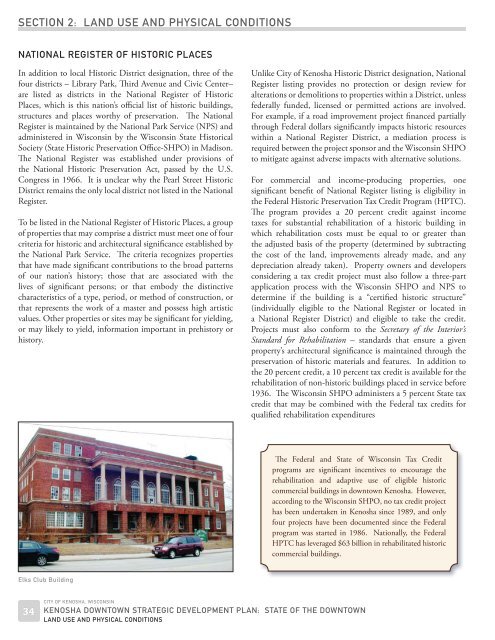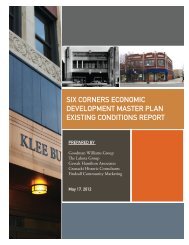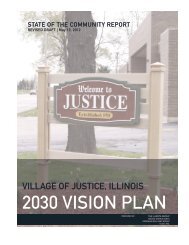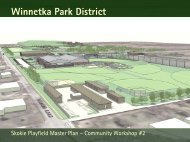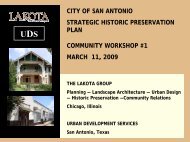Kenosha State of Downtown Report.indd - The Lakota Group
Kenosha State of Downtown Report.indd - The Lakota Group
Kenosha State of Downtown Report.indd - The Lakota Group
You also want an ePaper? Increase the reach of your titles
YUMPU automatically turns print PDFs into web optimized ePapers that Google loves.
SECTION 2: LAND USE AND PHYSICAL CONDITIONS<br />
NATIONAL REGISTER OF HISTORIC PLACES<br />
In addition to local Historic District designation, three <strong>of</strong> the<br />
four districts – Library Park, Third Avenue and Civic Center–<br />
are listed as districts in the National Register <strong>of</strong> Historic<br />
Places, which is this nation’s <strong>of</strong>ficial list <strong>of</strong> historic buildings,<br />
structures and places worthy <strong>of</strong> preservation. <strong>The</strong> National<br />
Register is maintained by the National Park Service (NPS) and<br />
administered in Wisconsin by the Wisconsin <strong>State</strong> Historical<br />
Society (<strong>State</strong> Historic Preservation Office-SHPO) in Madison.<br />
<strong>The</strong> National Register was established under provisions <strong>of</strong><br />
the National Historic Preservation Act, passed by the U.S.<br />
Congress in 1966. It is unclear why the Pearl Street Historic<br />
District remains the only local district not listed in the National<br />
Register.<br />
To be listed in the National Register <strong>of</strong> Historic Places, a group<br />
<strong>of</strong> properties that may comprise a district must meet one <strong>of</strong> four<br />
criteria for historic and architectural significance established by<br />
the National Park Service. <strong>The</strong> criteria recognizes properties<br />
that have made significant contributions to the broad patterns<br />
<strong>of</strong> our nation’s history; those that are associated with the<br />
lives <strong>of</strong> significant persons; or that embody the distinctive<br />
characteristics <strong>of</strong> a type, period, or method <strong>of</strong> construction, or<br />
that represents the work <strong>of</strong> a master and possess high artistic<br />
values. Other properties or sites may be significant for yielding,<br />
or may likely to yield, information important in prehistory or<br />
history.<br />
Unlike City <strong>of</strong> <strong>Kenosha</strong> Historic District designation, National<br />
Register listing provides no protection or design review for<br />
alterations or demolitions to properties within a District, unless<br />
federally funded, licensed or permitted actions are involved.<br />
For example, if a road improvement project financed partially<br />
through Federal dollars significantly impacts historic resources<br />
within a National Register District, a mediation process is<br />
required between the project sponsor and the Wisconsin SHPO<br />
to mitigate against adverse impacts with alternative solutions.<br />
For commercial and income-producing properties, one<br />
significant benefit <strong>of</strong> National Register listing is eligibility in<br />
the Federal Historic Preservation Tax Credit Program (HPTC).<br />
<strong>The</strong> program provides a 20 percent credit against income<br />
taxes for substantial rehabilitation <strong>of</strong> a historic building in<br />
which rehabilitation costs must be equal to or greater than<br />
the adjusted basis <strong>of</strong> the property (determined by subtracting<br />
the cost <strong>of</strong> the land, improvements already made, and any<br />
depreciation already taken). Property owners and developers<br />
considering a tax credit project must also follow a three-part<br />
application process with the Wisconsin SHPO and NPS to<br />
determine if the building is a “certified historic structure”<br />
(individually eligible to the National Register or located in<br />
a National Register District) and eligible to take the credit.<br />
Projects must also conform to the Secretary <strong>of</strong> the Interior’s<br />
Standard for Rehabilitation – standards that ensure a given<br />
property’s architectural significance is maintained through the<br />
preservation <strong>of</strong> historic materials and features. In addition to<br />
the 20 percent credit, a 10 percent tax credit is available for the<br />
rehabilitation <strong>of</strong> non-historic buildings placed in service before<br />
1936. <strong>The</strong> Wisconsin SHPO administers a 5 percent <strong>State</strong> tax<br />
credit that may be combined with the Federal tax credits for<br />
qualified rehabilitation expenditures<br />
<strong>The</strong> Federal and <strong>State</strong> <strong>of</strong> Wisconsin Tax Credit<br />
programs are significant incentives to encourage the<br />
rehabilitation and adaptive use <strong>of</strong> eligible historic<br />
commercial buildings in downtown <strong>Kenosha</strong>. However,<br />
according to the Wisconsin SHPO, no tax credit project<br />
has been undertaken in <strong>Kenosha</strong> since 1989, and only<br />
four projects have been documented since the Federal<br />
program was started in 1986. Nationally, the Federal<br />
HPTC has leveraged $63 billion in rehabilitated historic<br />
commercial buildings.<br />
Elks Club Building<br />
34<br />
CITY OF KENOSHA, WISCONSIN<br />
KENOSHA DOWNTOWN STRATEGIC DEVELOPMENT PLAN: STATE OF THE DOWNTOWN<br />
LAND USE AND PHYSICAL CONDITIONS


